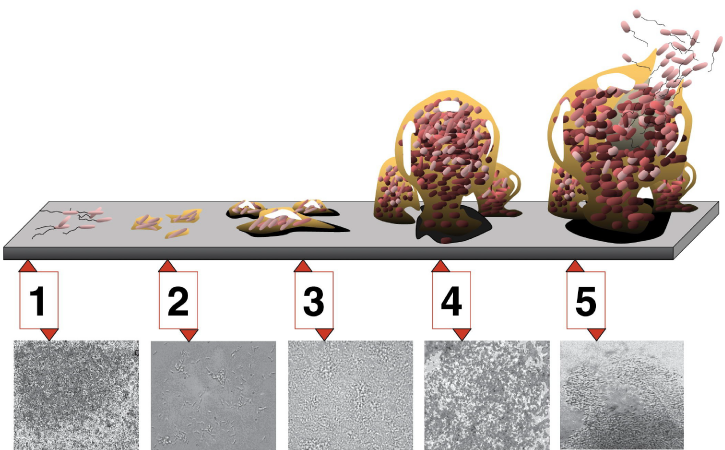| << Chapter < Page | Chapter >> Page > |
Is the VBNC state an unusual way of living for prokaryotes? In fact, most of the prokaryotes living in the soil or in oceanic waters are non-culturable. It has been said that only a small fraction, perhaps one percent, of prokaryotes can be cultured under laboratory conditions. If these organisms are non-culturable, then how is it known whether they are present and alive? Microbiologists use molecular techniques, such as the polymerase chain reaction (PCR), to amplify selected portions of DNA of prokaryotes, demonstrating their existence. Recall that PCR can make billions of copies of a DNA segment in a process called amplification.
Until a couple of decades ago, microbiologists used to think of prokaryotes as isolated entities living apart. This model, however, does not reflect the true ecology of prokaryotes, most of which prefer to live in communities where they can interact. A biofilm is a microbial community ( [link] ) held together in a gummy-textured matrix that consists primarily of polysaccharides secreted by the organisms, together with some proteins and nucleic acids. Biofilms grow attached to surfaces. Some of the best-studied biofilms are composed of prokaryotes, although fungal biofilms have also been described as well as some composed of a mixture of fungi and bacteria.
Biofilms are present almost everywhere: they can cause the clogging of pipes and readily colonize surfaces in industrial settings. In recent, large-scale outbreaks of bacterial contamination of food, biofilms have played a major role. They also colonize household surfaces, such as kitchen counters, cutting boards, sinks, and toilets, as well as places on the human body, such as the surfaces of our teeth.
Interactions among the organisms that populate a biofilm, together with their protective exopolysaccharidic (EPS) environment, make these communities more robust than free-living, or planktonic, prokaryotes. The sticky substance that holds bacteria together also excludes most antibiotics and disinfectants, making biofilm bacteria hardier than their planktonic counterparts. Overall, biofilms are very difficult to destroy because they are resistant to many common forms of sterilization.

Compared to free-floating bacteria, bacteria in biofilms often show increased resistance to antibiotics and detergents. Why do you think this might be the case?
Prokaryotes existed for billions of years before plants and animals appeared. Hot springs and hydrothermal vents may have been the environments in which life began. Microbial mats are thought to represent the earliest forms of life on Earth, and there is fossil evidence of their presence about 3.5 billion years ago. A microbial mat is a multi-layered sheet of prokaryotes that grows at interfaces between different types of material, mostly on moist surfaces. During the first 2 billion years, the atmosphere was anoxic and only anaerobic organisms were able to live. Cyanobacteria evolved from early phototrophs and began the oxygenation of the atmosphere. The increase in oxygen concentration allowed the evolution of other life forms. Fossilized microbial mats are called stromatolites and consist of laminated organo-sedimentary structures formed by precipitation of minerals by prokaryotes. They represent the earliest fossil record of life on Earth.
Bacteria and archaea grow in virtually every environment. Those that survive under extreme conditions are called extremophiles (extreme lovers). Some prokaryotes cannot grow in a laboratory setting, but they are not dead. They are in the viable-but-non-culturable (VBNC) state. The VBNC state occurs when prokaryotes enter a dormant state in response to environmental stressors. Most prokaryotes are social and prefer to live in communities where interactions take place. A biofilm is a microbial community held together in a gummy-textured matrix.
[link] Compared to free-floating bacteria, bacteria in biofilms often show increased resistance to antibiotics and detergents. Why do you think this might be the case?
[link] The extracellular matrix and outer layer of cells protects the inner bacteria. The close proximity of cells also facilitates lateral gene transfer, a process by which genes such as antibiotic resistance genes are transferred from one bacterium to another. And even if lateral gene transfer does not occur, one bacterium that produces an exo-enzyme that destroys antibiotic may save neighboring bacteria.

Notification Switch
Would you like to follow the 'Biology' conversation and receive update notifications?